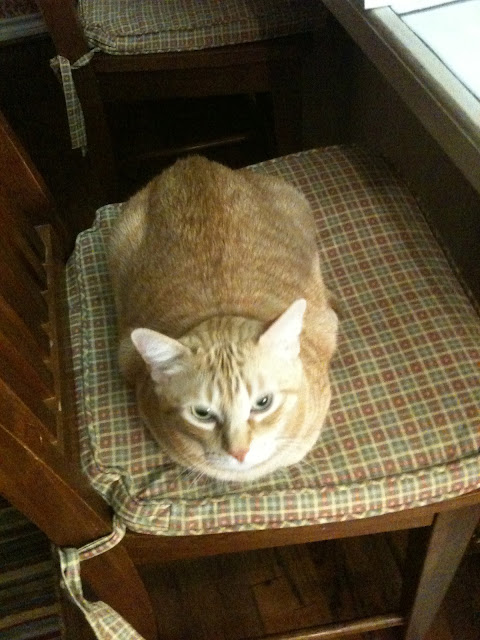I have some old cast iron cornbread molds given to me by my mother. They've not been used in ages, and were rusty and dirty. Here's how I fixed them up.
1. First, find yourself a good assistant. Fortunately, I had Marmalade here to lend me a paw.

2. Next, you need to clean your cast iron. In the image below, you will see how rusty and stained the old cornbread molds were. Using a good sponge and water (do NOT use soap!) scrub off as much rust and grime as you can. On some items you may have to use very fine steel wool for this, but it's best to test a small area first and make sure there's no scratching. I just used a sponge in this case.
3. Once you have it cleaned and dried, place it in a 300 degree oven for about 10 minutes. This heats it up and helps it to absorb the coating. Once it's good and hot, carefully remove it from the oven and let it sit until it is cool enough to handle comfortable, but still warm. At this stage, you need to apply the seasoning. I use plain old Crisco, but you can also use vegetable oil. Do NOT, however, use olive oil because it will go rancid! Apply a thin coating to the entire cast iron piece, using your fingers or a soft cloth. It's important to apply enough, but do not go overboard because you can end up leaving a tacky film. Below you can see the greased cast iron molds.
4. Now that you've got your coating on, put the cast iron in the oven at about 325-350 degrees for an hour and a half. It's best to put down a cookie sheet with some foil over it on the lower rack beneath the cast iron; this will help catch any drips. Now, while it's baking you will smell a strange metallic smell; this is nothing to worry about.
5. When the hour and a half is done, turn off the oven, open the door, and let the cast iron gradually cool down. When it's completely cool, take it out and voila! You are all done. Your cast iron piece is now restored and ready to cook with. Be sure to maintain your results by IMMEDIATELY cleaning it out after each use using only water and a soft cloth. You will probably need to re-season it every year or so. Below, you can see my finished result. Look at how pretty and black it turned out! Nothing cooks like cast iron does.
In other news, I have returned to the South for a few weeks to visit family. I already miss my new home in the Pacific Northwest, and am very much looking forward to returning next week.




Can I send you my cauldrons to do? I keep looking at them and putting it off for another day....
ReplyDeleteMaybe I should start a little business! "Cauldron seasoning while you wait...." Haha.
ReplyDelete